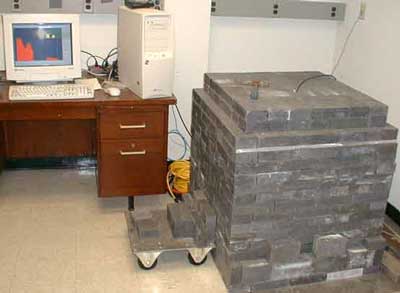Design and Construction of a
Gamma-ray Spectrometer System for Determining Natural
Radioelement Concentrations in Geological Samples at the U.S.
Geological Survey in Reston, Virginia
By
Stephen L. Snyder 1 and
Joseph S. Duval
1
1 U.S. Geological Survey, MS 954, 12201
Sunrise Valley Drive, Reston, VA 20192
U.S. Geological Survey Open-File Report
03-029
Online Only
2003

Photograph of
completed gamma-ray spectrometer measurement
system.
(Click on photo to view larger
image)
Introduction
A gamma-ray spectrometer
system was constructed for the quantitative analysis of the
naturally occurring radioelements potassium (40K), uranium (238U), and thorium (232Th) in geologic reference samples, rocks
and soils. If the
gamma-ray measuring system is properly calibrated (Grasty and Darnley, 1971), the gamma-ray
data can be expressed in terms of the estimated concentrations of
the radioactive elements. Potassium concentrations are usually
expressed in units of percent (percent K); uranium concentrations
are expressed as parts per million equivalent uranium (ppm eU);
and thorium concentrations are expressed as parts per million
equivalent thorium (ppm eTh). The term “equivalent” is
used because the technique measures gamma-rays from the decay
series of bismuth (214Bi), which
is a decay product of uranium (238U), and thallium (208Tl), which is a decay product of thorium
(232Th). Radioactive disequilibria in the
decay series of uranium and thorium may make the equivalent
concentrations differ from the actual concentrations of these
elements present in rock or soil (Adams
and Gasparini, 1970). Further discussions of the
geochemistry of the three radioelements can be found in (Hansen, 1980) and (Faul, 1954).
This gamma-ray spectrometer system is located at the Physics
Building on the grounds of the U.S. Geological Survey in Reston,
VA. It consists of a gamma-ray spectrometer sensor (a crystal of
thallium-activated sodium iodide) attached to a photomultiplier
tube, which is housed inside a lead chamber (also known as a
"castle") with walls 8" thick. The photomultiplier tube is
connected by means of a cable to a PC running computer software
to collect the data. The castle is made using lead (low-level
radioactivity) bricks measuring 8" by 4" by 2". An opening in
one side of the castle allows placement of the sample directly
beneath the detector by means of an aluminum sample holder. This
opening is then sealed by rolling a dolly carrying lead bricks up
against the side of the castle. The sensor is held in place
above the sample by means of a support assembly made from sheets
of aluminum. Another sheet of aluminum is placed on top of the
castle opening and three layers of lead bricks are placed on top
of this aluminum sheet. To allow the passage of the cable from
the photomultiplier tube to the PC, a hole was drilled through
the aluminum sheet and the three layers of lead bricks above it.
The lead bricks were drilled in such a way that the cable
zig-zags through the layers of lead bricks, thus preventing any
direct path into the castle chamber. A 137Cs source is used as a reference for
making measurements and is located within the lead castle. A
small sheet of 1/4" thick lead is placed between the 137Cs source and the detector to block some
of the gamma-rays. The design and construction of these
components are given in more detail by clicking on the links
below. For a further discussion of laboratory instrumentation and
similar systems, see Adams and
Gasparini, 1970, pp. 68-88.
Sample Requirements
Samples to be measured can vary in
weight, particle size and composition. However, due to the
dimensions of the opening in the castle, along with the sample
holder, the largest sample container that will fit into the
system is 6" in diameter and 1.5" deep. The sample holders used in this system are
made from a clear polystyrene (or similar) plastic and are sealed
with vinyl electrical tape to prevent the escape of radon and
moisture from the sample. Depending on density, typical samples
range in weight from about 400 to 900 grams. Geological
reference standards are generally 600 grams. The samples don't
require any special preparation.
Top || Software || Hardware || Construction || References || Photos || Data
This report is preliminary and
has not been reviewed for conformity with the U.S. Geological
Survey editorial standards. Any use of trade, product, or firm
names is for descriptive purposes only and does not imply
endorsement by the U.S. Government.

